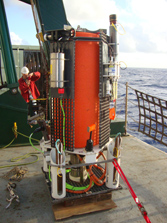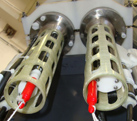
The ALOHA-Mars Mooring (AMM) Secondary Node is the perch for three sensing instruments as well as a power/communications source for those instruments and others. Two of the instruments are identical - each with sensors measuring salinity, temperature, pressure and oxygen.

The third instrument, called a Fluorometer, uses light to measure the amount of particles in the water. Suspended particles can come from above in the form of sinking organisms - plankton - and nutrients (i.e., "poop"), called marine snow. Some of this snow may contain chlorophyll originating in the surface ocean.; this can be detected by the fluorometer. The snow can also be a result of turbidity - the sediment in the ocean being stirred up by water movement as a riverbed when you dig your toes into it. The video during deployment shows there is abundant marine snow.

Often called the bird perch or the water heater, the AMM has a distinct compact shape designed to be easily moveable by a remotely operated vehicle, in this case a robot called Jason. The big orange cylinder is syntactic foam flotation (little glass spheres filled with air and held together by epoxy) that makes the complete package just a little heavier than water, and easy for Jason to pick up and move. The AMM descended by free fall to the sea floor and it had a speed up to 100 meters per minute, within 50 meters of the target.
When deployed at Station ALOHA, the AMM was already a salty fellow - an experienced sea-goer - with barnacles to prove it. It gained these barnacles during its installation in Puget Sound, Washington four years ago where it was one part of another oceanographic technology effort, the ALOHA-MARS Mooring project. This project developed a profiler to run up and down a water-column spanning mooring, charging its batteries just like an electric toothbrush. Such a system is intended for the ACO as one of the next steps.